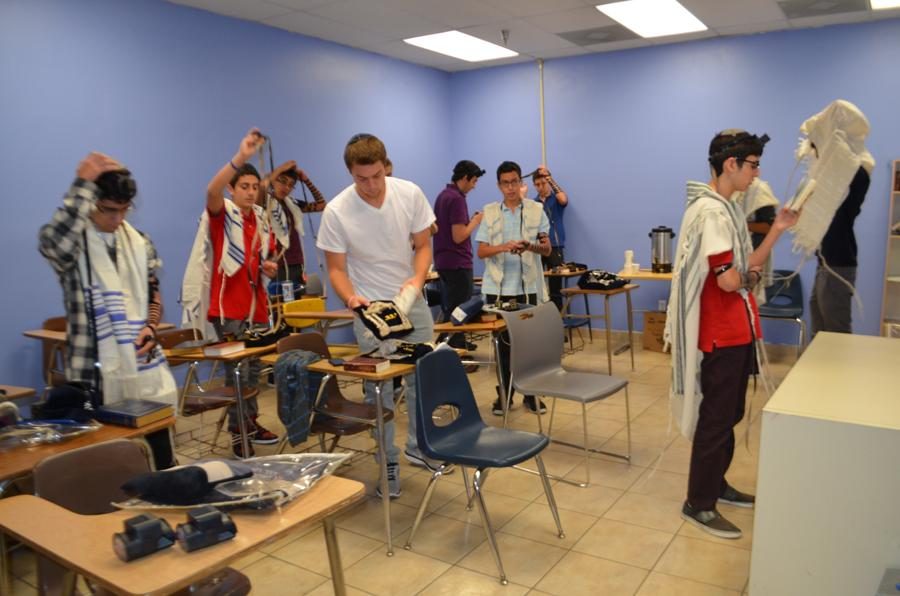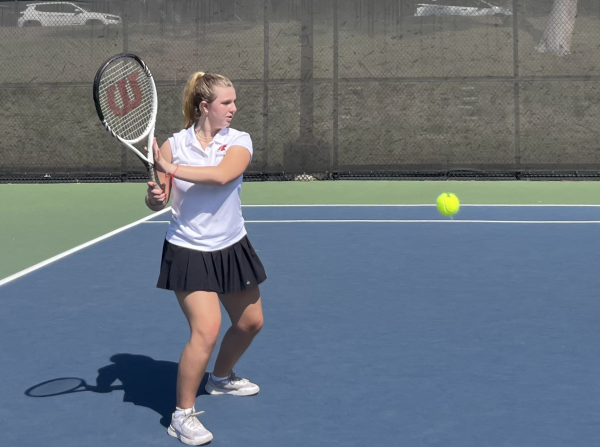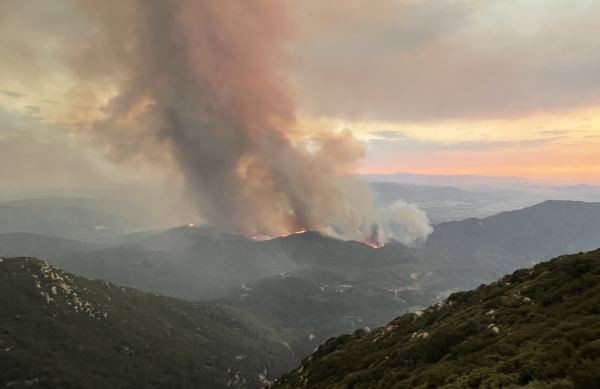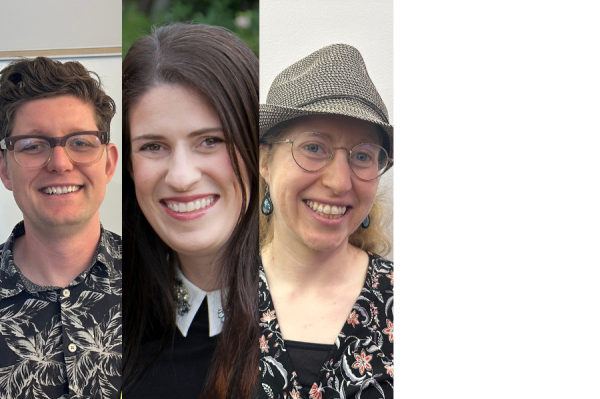Students praise davening system that gives them four choices
STUDENT-LED: Boys donned tefillin during Shacharit at a recent Sephardic Minyan. Along with girls (not shown) on the other side of the mechitzah, they are happy to pray according to their Sephardic customs.
November 10, 2012
It’s Monday morning after first period and students disperse to four locations. Most head towards the Beit Midrash for the main Ashkenaz Minyan. Some will move underground, to the Sephardic minyan across the hall from the basement Science Lab. An Alternative Girls Minyan will gather in the Student Lounge, and most senior girls will be in Mr. Feld’s double classroom, Room 44.
With four distinct davening prayer services each morning, most open to whoever prefers them, this year’s davening system is an attempt to reach out to a variety of students and their beliefs.
“People in the Sephardic minyan are there to pray,” said senior Adam Wannon, a founder and active participant there. “There is no ‘shushing’ to get people quite. Everyone is motivated to daven in our Sephardic custom.”
Though their service is very different, members of the Girls Alternative Minyan feel the same way.
“We all get a chance to hear each other speak and be more interactive,” said senior Rachel Friedman. “Not only does it boost people’s confidence, but it can even make people feel more spiritually connected because they are more active and involved.”
Judaic Studies Director Mr. Noam Weissman said this year’s system is the culmination of a gradual effort by the Judaic Studies Department to make davening both more serious and more comfortable for students who have different personalities and needs.
“The school is separated [into davening groups] to give the optimal davening experiences for our diverse student body, while not being so divided so as to take away the unity important in building a school community,” Mr. Weissman said.
The davening groups have changed over the years. Some years the student body was divided by grades, or by gender, or both. There were other years when any group could form its own minyan. This year students can choose where they go.
“On the one hand, this was the plan all along,” Mr. Weissman said, referring to recent years’ efforts by Judaic Studies teacher Mr. Jason Feld and former Judaic Studies Principal Rabbi Ari Leubitz. “In previous years Shalhevet’s davening could have been much stronger. However, Rabbi Leubitz, Mr. Feld and I knew that it would take a few more years for davening to get as serious, decorous and hopefully meaningful as it is now.
“Now, Reb Tuli and the Judaic staff put in place what we think is the best possible way for our students to simply daven.”
Reb Tuli Skaist, who also teaches Talmud, Tanach, and 12th grade Jewish Philosophy, leads the largest minyan, the Ashkenaz minyan in the Bet Midrash. It is the main minyan for all ninth- to 11th-graders, plus Ashkenaz senior boys.
With three rows on each side of the *mechitzah, students fill them following along with the chazzan. The *tefillot comprise of song and silent prayer, everyone rises together with the recital of *Kaddish. In the aisles between the chairs, Reb Tuli, Rabbi Stein, Mr. Feld, and Reb Noam pace back and forth with *siddurim in their hands, policing the minyan.
Still, tefilah [prayer] is difficult for many students.
“When I’m in davening I am bored because I do not know what the words mean,” said sophomore Tom Amzalag. “As a result my desire to daven weakens.”
But the Main Minyan as also a halakha yomit — literally, “law of the day” — at the conclusion of Pesukei D’zimra, so students understand both the meaning and :know-how” of prayer.
“We are learning more knowledge overall about how to daven, for example you have to sit in your makom kavua (fixed place),” added Tom.
The Sephardic minyan is led by Shalhevet’s newest rabbi, Rabbi Aharon Assaraf, along with Mr. Josh Horwatt, Director of Student Support. About 25 students come to this minyan with around a three-to-one boy-to-girl ratio.
At the Sephardic Minyan, chairs are orderly aligned with Rabbi Assaraf davening in the front of the room. With each person murmuring the prayers to themselves, the chazzan recites every word aloud. After davening, the students refresh themselves with fresh tea.
Head of School Rabbi Ari Segal gave Sephardic students permission to start their own davening last November, after several Sephardic students started asking to daven in their traditional, non-Ashkenazic nussach*, or style. The Sephardic minyan also created a service where girls did not carry the Torah, which was more familiar from what Sephardic students experience in their home synagogues.
“I get a sense of community from the Sephardic minyan,” said sophomore Adam Rokah. “You can feel the warmth among one another.”
During Shacharit, Rabbi Assaraf sometimes points out certain parts of the davening with Sephardic customs. Other times, he addresses a quick halacha about silence, rather than stopping the minyan for minutes at a time – making it an efficient minyan.
Motivation is what is credited for the success of the group, especially since some non-Sephardim have joined.
“It is inspiring to me thateveryone is there by choice,” Mr. Horwatt said. “We have zero issues of discipline or disrespect because the students are the ones responsible.”
Junior Benny Balasz, who is Ashkenazic, also attends.
“In the Sephardic minyan, we go through all necessary prayers and do not bother to worry about time,” said Benny. “The kavana [focus and sincerity] in the Sephardic minyan is very visible.”
The least traditional minyan, the Girls Alternative Davening Group, meets in the Student Lounge, where Judaic Teacher Mrs. Ruthie Skaist engages in a casual discussion with students. Sitting on chairs and couches and forming a circle, they discuss issues such as free will and death penalty in Judaism.
An outgrowth of what used to be called the Yoga Minyan, the idea this year is for girls to pray through innovative, spiritual connecting, members said. Most of the members are senior girls, but there are some juniors and sophomores as well.
Rachel Friedman said the old Yoga Minyan was also discussion-based, but started with yoga and stretching. Rachel said this is a serious group with a different way to spiritually connect.
“We’re not really supposed to call it ‘yoga minyan’ anymore since yoga isn’t at all a part of it like it used to be,” Rachel said. “Someone brings up a spiritual, Judaic topic, usually one that is controversial, and we go around, everybody having a chance to express an opinion in a judgment-free environment.”
Senior girls who don’t choose to attend the Alternative Davening group, Sephardic Minyan, or Ashkenaz minyan are a part of the Senior Girls Minyan led by Rabbi Schwarzberg.
Rabbi Schwarzberg leads the girls by saying the first and last verse of each prayer. Everything else is said silently and there is no Kaddish.
“I really like it,” said senior Emilie Benyowitz, satisfied with her new davening group. “I was in the yoga minyan last year because I couldn’t handle the regular davening. In this minyan we say the main parts of davening…it’s much easier to pay attention for 12 minutes rather than 25.”
Mr. Weissman said he is confident that there will be increasing success this year.
“In my four years here, I have never seen davening go so well,” Mr. Weissman said. “Much of this is due to Reb Tuli Skaist’s leadership of the main minyan and the inspiring and beautiful tefila that the Sephardim have every day.”













